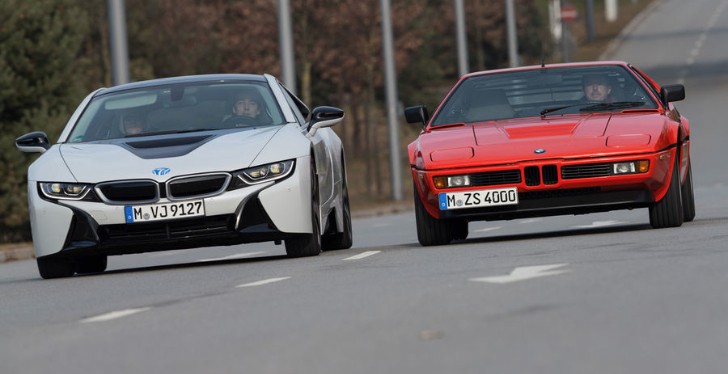It’s been 33 years since the only supercar BMW ever made went out of production and yet, another iconic car in the history of the Bavarian company is here to take its place, the i8.
The two are both similar and extremely different in their own ways but the guys from Auto Motor und Sport had the chance to have them both on their hands to test out and see just how much can a car advance in over 3 decades. As it turns out, a lot!
Sure, the M1 was and still is called the only supercar BMW ever made. Looking over what that term means today, you might think we’re crazy but back in the 1970s, the mid-engined Bimmer was truly a rare bird and an unbelievably fast car that was outshone only by 2 cars of the same period: the Ferrari BB512 and the Porsche 911 Turbo but, as the name suggests, the latter had a turbocharger.
Sticking to the same old recipe they knew, the Motorsport engineers gave the M1 a 3.5-liter inline 6-cylinder engine that made 277 HP that used mechanical injection and was mounted towards the center of the car, making it the first ever mid-engine BMW.
0-62 mph (100 km/h) sprint was done in 5.6 seconds and it was slower than just 2 other cars in the world, that we already mentioned, but even back then the EfficientDynamics mentality was still at play, not-knowingly, of course. Compared to the Ferrari and the Porsche, the M1 was a lot less thirstier and returned an average fuel consumption of 16.7 l/100 km (14 mpg). It might seem huge by today’s standards but it was peanuts for back then.
Speaking of fuel consumption, that’s where the i8 steps in, brilliantly. Being made out of carbon fibre reinforced plastic, the new hybrid will supposedly do, on average, 2.5 l/100 km (94 mpg) while also obliterating the numbers of the M1 on straight-up drag racing.
The all-wheel-drive car will do 100 km/h (62 mph) in 4.4 seconds thanks to its powertrain made up of incredibly smaller engines. The internal combustion unit has only 1.5-liters in displacement but makes 231 HP and 320 Nm of torque. On the other hand, the electric motor makes 131 HP and 250 Nm of torque from 0 RPM, therefore turning lag into just another silly word in the dictionary. Combined, the two motors make more power than the M1, 362 HP and 570 Nm of torque in total while also being lighter overall.
So, the two do share some similarities but it’s the differences that make them who they are. The M1 was heavily used in motorsport and that was its main purpose, few of them actually ending up in private collections and that’s what made it iconic.
On the other hand, the i8 was built to keep mobility as we know it alive. Without combining electric engines with traditional combustion ones we couldn’t keep on enjoying cars as we used to. The i8 is a statement for the future.
Sure, the M1 was and still is called the only supercar BMW ever made. Looking over what that term means today, you might think we’re crazy but back in the 1970s, the mid-engined Bimmer was truly a rare bird and an unbelievably fast car that was outshone only by 2 cars of the same period: the Ferrari BB512 and the Porsche 911 Turbo but, as the name suggests, the latter had a turbocharger.
Sticking to the same old recipe they knew, the Motorsport engineers gave the M1 a 3.5-liter inline 6-cylinder engine that made 277 HP that used mechanical injection and was mounted towards the center of the car, making it the first ever mid-engine BMW.
0-62 mph (100 km/h) sprint was done in 5.6 seconds and it was slower than just 2 other cars in the world, that we already mentioned, but even back then the EfficientDynamics mentality was still at play, not-knowingly, of course. Compared to the Ferrari and the Porsche, the M1 was a lot less thirstier and returned an average fuel consumption of 16.7 l/100 km (14 mpg). It might seem huge by today’s standards but it was peanuts for back then.
Speaking of fuel consumption, that’s where the i8 steps in, brilliantly. Being made out of carbon fibre reinforced plastic, the new hybrid will supposedly do, on average, 2.5 l/100 km (94 mpg) while also obliterating the numbers of the M1 on straight-up drag racing.
The all-wheel-drive car will do 100 km/h (62 mph) in 4.4 seconds thanks to its powertrain made up of incredibly smaller engines. The internal combustion unit has only 1.5-liters in displacement but makes 231 HP and 320 Nm of torque. On the other hand, the electric motor makes 131 HP and 250 Nm of torque from 0 RPM, therefore turning lag into just another silly word in the dictionary. Combined, the two motors make more power than the M1, 362 HP and 570 Nm of torque in total while also being lighter overall.
So, the two do share some similarities but it’s the differences that make them who they are. The M1 was heavily used in motorsport and that was its main purpose, few of them actually ending up in private collections and that’s what made it iconic.
On the other hand, the i8 was built to keep mobility as we know it alive. Without combining electric engines with traditional combustion ones we couldn’t keep on enjoying cars as we used to. The i8 is a statement for the future.





















